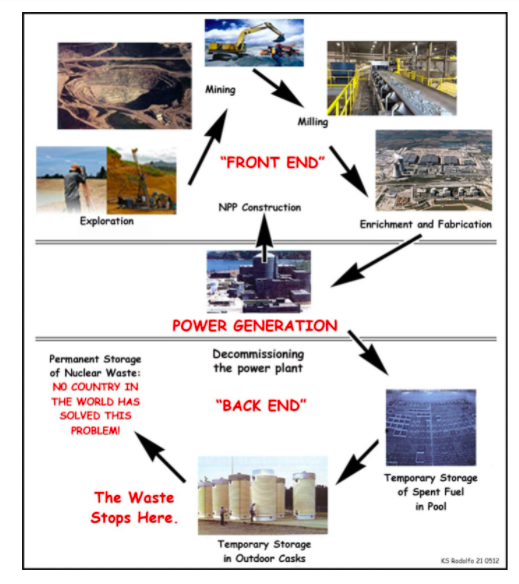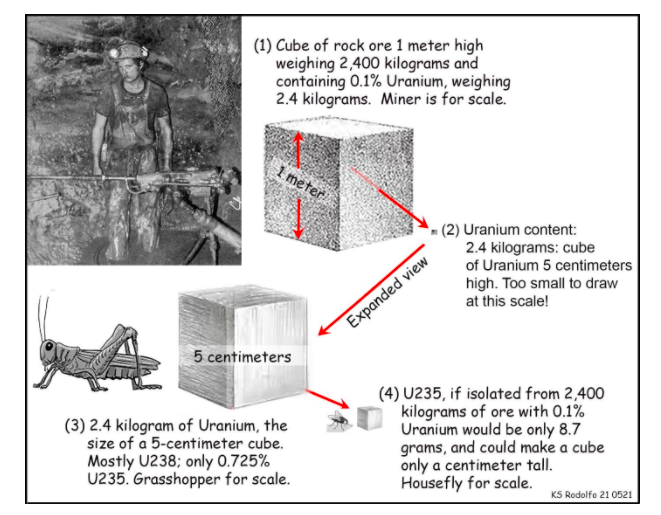SUMMARY
This is AI generated summarization, which may have errors. For context, always refer to the full article.
![[OPINION] Introducing the nuclear fuel cycle](https://www.rappler.com/tachyon/2021/09/TL-nuclear-fuel-cycle-October-01-2021.jpg)
The following is the 15th in a series of excerpts from Kelvin Rodolfo’s ongoing book project “Tilting at the Monster of Morong: Forays Against the Bataan Nuclear Power Plant and Global Nuclear Energy.“
Everyone needs to understand that the International Atomic Energy Agency, the nuclear industry’s World Nuclear Association, and Mark Cojuanco’s House Bill 4631 to activate the Bataan Nuclear Power Plant all exist to promote nuclear power. They propagandize accordingly.
One of their most dishonest and cynical claims is that nuclear energy is the answer to global warming and climate change, because it emits almost no greenhouse carbon dioxide. This falsehood is widely believed and glibly repeated by many people in public office, some naively who should know better, others cynically. It is especially irksome for an environmental scientist.
Exposing this falsehood is one of the main reasons I’m writing this book. Since 1975, when Wallace Broecker warned about “a pronounced global warming,” I have studied and taught about how humans, burning fossil fuels, are warming the globe and catastrophically changing our climate.
True, an operating nuclear reactor generates little carbon dioxide. But the propagandists know full well that it needs uranium. It must be found, mined, milled, and processed, all steps that use large amounts of fossil fuel and release much carbon dioxide. They also rarely admit that handling reactor waste and decommissioning NPPs will also burn much fossil fuel and release much CO2.
How much CO2? It will take us five forays to estimate. Meanwhile, dear readers, these pictures of Australia’s enormous main open pit Ranger mine, roughly a mile or one and a half kilometers in diameter, and at least 126 meters deep, should give you a general sense of the great quantities of diesel oil used by mining machinery.

What is remarkable is how little nuclear fuel came out of this gigantic hole: only about 126,000 tons of uranium oxide.
We will learn the real costs of uranium fuel in money and CO2 by exploring the nuclear fuel cycle. The cycle has a “front end” and a “back end.”
The “front end” includes all the processes that make the fuel before it reaches the reactor. This must also include the costs of building the plant; in the case of the 621-megawatt BNPP, $2.9 billion, including financing the corruption and debt. There was so much corruption, we will never really know how much diesel and gasoline was burned to build BNPP, releasing how much greenhouse CO2 into the atmosphere. But these have to be substantial.
If BNPP is ever activated and generates electricity at capacity and continuously day and night for 40 years, each kilowatt-hour will have already cost 50 centavos in construction, corruption, and interest alone.
The front end begins by finding the minable ore. Locating it uses much geological and geophysical technology, much traveling about in aircraft and vehicles powered by gasoline and diesel, much drilling, sampling, and assaying. Most of those costs are no longer incurred because there are virtually no more deposits to be found anywhere, but every fuel rod bears a cost in both money and in CO2 released to the atmosphere by exploration.

Most of the front end consists of mining and milling the ore, extracting and enriching its uranium, making fuel pellets and rods, and delivering them to the reactor.
The “back end” is everything that has to be done to close the NPP at the end of its life; also, and most important, to handle and store the radioactive waste. This will have uncertain but certainly enormous costs in treasure and CO2 generated. As we will see, no one knows how to do this. Meanwhile, the wastes keep accumulating at NPPs all the world.
The nuclear cycle, it turns out, is no “cycle.” The flow of fuel-into-the-NPP-and-waste-out-of-it is stalled at power plants all over the world, where the waste has been piling up in pools and casks, ever-growing hazards since operation began.
To fuel BNPP
A year’s worth of fuel for the 621-megawatt BNPP would require 100 tons of raw uranium metal to be extracted from the earth. In our times, a rock has to contain at least 0.1% of uranium to be commercially minable. The richest ores of any metal are always mined first, of course, and so the ores of the future will contain less and less uranium, and will cost more to process.
But for now, the cutoff is 0.1%. So 100,000 tons of rock this rich has to be found and processed. (More, because only about 95% can be recovered, but let’s keep it simple.)
To get the uranium out of the ore rocks, they have to be found, mined, milled, and the metal fragments sorted out, all this by machinery powered by gasoline and diesel fuel and by electricity generated with fossil fuels.
Before our next foray about how uranium is actually mined and milled, a picture helps to give some sense of the huge quantities of rock that have to be processed to make BNPP’s annual hundred tons of uranium. This one shows an imaginary cube of granitic rock ore with a miner standing next to it for scale. To simplify our arithmetic, each side is a meter long.
Weighing 2,400 kilograms, this cube would be one of 47,000 that make up 100,000 tons. It contains only 0.1% uranium, which works out to 2.4 kilograms, symbolized by the imaginary 5-centimeter cube next to the grasshopper.

Later, we will also look at the fate of the great piles of mine waste that have yielded such a tiny amount of uranium. More than 100,000 tons is added every year to vast, growing piles of rock waste containing radioactive material. Crushed and milled, the waste is easily weathered and leached by the elements. Radioactive water filtering through it contaminates both streams and groundwater.
Uranium comes in six atomic forms called isotopes – varieties that share the same name and chemical behavior but have slightly different weights. “Isotope” is Greek for “same place,” which they all share in the periodic table of the chemical elements.
Four of the six uranium isotopes are so rare we can ignore them altogether. The rarest of the remaining two is Uranium 235, or U235 for short. For now, let’s just say the “235” is the atom’s weight in “atomic mass units.” We will look more closely at isotopes, radioactivity, and “half-life” later.
U235 atoms are rare indeed. There are only seven of them for every thousand atoms of slightly heavier Uranium 238, which is overwhelmingly the most abundant isotope. Those seven U235 atoms together weigh only 0.7% of the element.
But U235 is the isotope that empowers nuclear weapons and reactors. And so the main goal of all that mining is symbolized in the drawing by the tiny imaginary cube of U235 weighing 8.7 grams, not much bigger than a housefly, in a cubic meter of rock.
This drawing is also very imaginary in another sense. In reality, the U235 atoms are still very sparsely scattered throughout the uranium after milling. Leaving the mill, the uranium still has to undergo complex, energy-intensive processing to increase its U235 content up to 3-5%, the content of reactor fuel. Only the Uranium 235 for nuclear weaponry is concentrated close to purity, to 90%.
How U235 is actually mined and milled, we will explore next. – Rappler.com
Keep posted on Rappler for the next installment of Rodolfo’s series.
Born in Manila and educated at UP Diliman and the University of Southern California, Dr. Kelvin Rodolfo taught geology and environmental science at the University of Illinois at Chicago since 1966. He specialized in Philippine natural hazards since the 1980s.
Previous pieces from Tilting at the Monster of Morong:
- [OPINION] Tilting at the Monster of Morong
- [OPINION] Mount Natib and her sisters
- [OPINION] Sear, kill, obliterate: On pyroclastic flows and surges
- [OPINION] Beneath the waters of Subic Bay an old pyroclastic-flow deposit, and many faults
- [OPINION] Propaganda about faulting, earthquakes, and the Bataan Nuclear Power Plant
- [OPINION] Discovering the Lubao Fault
- [OPINION] The Lubao Fault at BNPP, and the volcanic threats there
- [OPINION] How Natib volcano and her 2 sisters came to be
- [OPINION] More BNPP threats: A Manila Trench megathrust earthquake and its tsunamis
- [OPINION] Shoddy, shoddy, shoddy: How they built the Bataan Nuclear Power Plant
- [OPINION] Where, oh where, would BNPP’s fuel come from?
- [OPINION] ‘Megatons to Megawatts’: Prices and true costs of nuclear energy
- [OPINION] Uranium enrichment for energy leads to enrichment for weapons
Add a comment
How does this make you feel?
There are no comments yet. Add your comment to start the conversation.